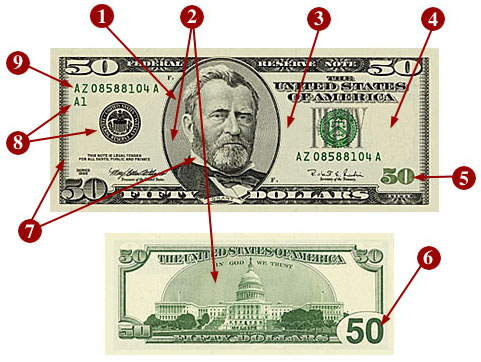

The Bureau of Engraving and Printing is in charge of designing new ways to deter counterfeiting. In 1996, the $100 bill was redone and in 1997 the $50 bill was redone to include the latest security features.

1) One of these features is the picture on the bill. Each President is on only one bill and the face is more lifelike than on a fake bill.
2) There are fine lines printed behind the president and behind the building on the other side. These lines are smooth and unbroken.
3) There is also a polymer thread woven in the bill. The thread in the $100 bill reads "USA 100" and the $50 bill reads "USA 50". The thread can't be reproduced with copiers or printers but is visible when the bill is held up to a light or appears yellow when in ultraviolet light. Genuine bills also have red and blue threads embedded in the paper. On counterfeit bills the lines look like they are printed on the paper but on genuine bill the lines appear to be in the paper.
4) There is a watermark or "shadow" to the right of the face on the bill. It isn't visible unless the bill is held up to the light.
5) Color shifting ink is used for the number in the lower right hand corner on the front of the bill. The ink appears green until the bill is held at an angle, then the ink looks black. The ink is also "never dry" ink, which means that it can be rubbed off. Be careful, the ink on fake bills can also be rubbed off at times.
6) On the $50 bill the number 50 is printed in large print to make it easier to see.
7) On the $100 bill microprinted words are written around the portrait. To the naked eye it looks like a black line but under a microscope the words "The United States of America" can be read. On the $50 bill, "50" is written around the portrait and "United States of America" is printed in Grant's collar.
8) Genuine bills have the Federal Reserve and Treasury seals printed on them. The saw-tooth points on the seal are clear, distinct, and sharp. The seals on counterfeit bills may have uneven, blunt, or broken points.
9) Along with the seals on each bill there is a serial number printed in the same color ink as the seal and the numbers and letters are evenly spaced.
![]()

![]()
The picture at the top of the page is Alexander Hamilton who is found on the front of the $10 bill. The US Treasury building is on the back of the bill.